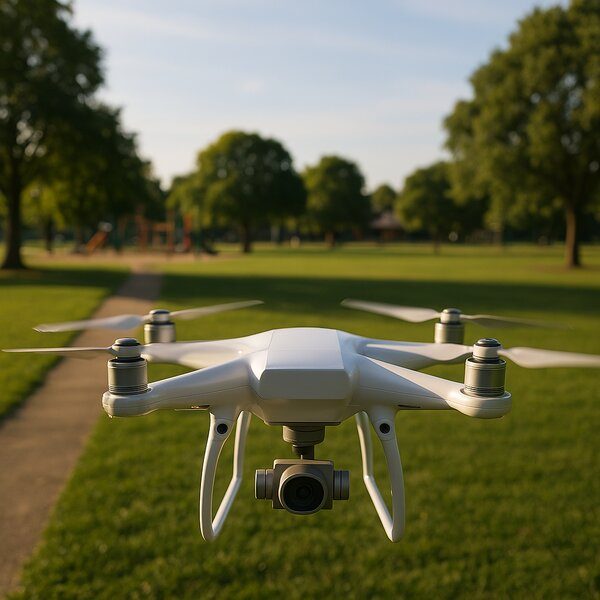Can I Fly a Drone in a Park?
Whether you’re a hobbyist pilot or simply curious about drone regulations in your area, one of the most common questions is: can I fly a drone in a park? In this comprehensive guide, we’ll break down the rules around drone usage in public spaces, including local ovals, parks, and school grounds in Australia. We’ll also clarify what’s allowed, what to avoid, and how to stay compliant while enjoying recreational drone flying.

Understanding CASA Regulations
In Australia, the Civil Aviation Safety Authority (CASA) regulates drone usage. These rules apply to all drone operators, whether recreational or commercial. Before you lift off in a public space, it’s important to understand the standard operating conditions:
- Your drone must be under 2 kg if flying recreationally without a Remote Pilot Licence (RePL).
- You must fly in visual line-of-sight at all times.
- You cannot fly higher than 120 metres above ground level.
- Stay at least 30 metres away from people not involved in the flight.
- No flying over or near emergency operations, sporting events, or populated areas.
These regulations are general guidelines, but specific areas like public parks may have additional restrictions depending on local council rules.
Can I Fly a Drone in a Public Park?
If you’ve ever asked, can I fly a drone in a public park?, the answer is: it depends on the location and who manages the park. In most cases, flying a drone in your local park is allowed if you follow CASA rules. However, many councils and park management authorities have their own drone policies.
To avoid fines or complaints, it’s best to check your local council’s website or call them directly. Some councils require permission, especially for larger drones or where other people are present. Others allow recreational drone flying with no additional permits, provided you follow the standard drone rules.
Drone Parks and Designated Flying Areas
The term drone park is sometimes used to refer to designated areas where drones are explicitly allowed. These are often located within model aircraft clubs or areas set aside by councils to promote safe drone flying. While not every city or town has an official drone park, it’s worth checking whether there’s a designated area near you. Flying in approved drone parks gives you peace of mind and may even connect you with other drone enthusiasts.
Can I Fly My Drone at a Park That Is Not Populated?
Even if the park is empty, the same CASA rules apply. While you may not risk collisions with people, you still need to maintain visual line-of-sight and stay under 120 metres high. If the space is truly isolated, it may offer a perfect environment to practise flying or capture some scenic footage, assuming the local council allows it.
Can I Fly a Drone in a Local Oval?
Flying a drone in a local oval can seem like a good idea, especially when it’s not in use. However, most ovals are managed by councils or schools. If it’s a school oval, even if used out of hours, you technically need permission from the school or department of education. For council-managed ovals, the same rule applies: check your local drone policy. Some ovals double as public parks and may fall under general park guidelines.
Can I Fly a Drone in a School Ground After Hours?
This is a grey area. School grounds are not public property and are managed by educational departments or private operators. Even outside of school hours, flying a drone without permission is considered trespassing and may be illegal. While you might not be stopped immediately, doing so risks penalties and could lead to police involvement.
National Parks Are a No-Go (Mostly)
Flying in national parks is generally prohibited unless you’ve obtained specific permission. You can read more about this in our national parks drone guide. This article, however, focuses on local and public areas like neighbourhood parks and ovals, where the rules can be more lenient — or more confusing.
Tips to Stay Compliant When Flying in a Park
- Fly early in the morning or at quiet times to minimise risk of bothering others.
- Keep your drone under control at all times. Sudden gusts or GPS errors can lead to accidents.
- Always carry your drone’s serial number and proof of ownership. Some councils may request it if questioned.
- Respect birds, wildlife, dogs, and children — even if the area is legally flyable, it doesn’t mean it’s appropriate.
- If a sign says “No Drones”, don’t fly — even if CASA rules would otherwise permit it.
What If I Want to Fly Commercially in a Park?
If you’re looking to fly for commercial purposes — for instance, real estate footage, promotional content, or business use — you’ll need a Remote Pilot Licence (RePL). You may also need approval from the council and landowners, and if you’re operating under an Operator’s Certificate (OC), mission planning and flight approvals are essential.
Drone Training: Know the Rules, Fly with Confidence
If you love drones and want to understand the legal and technical side of flying, we offer fully accredited Remote Pilot Licence (RePL) training. This opens the door to flying commercially, earning income from drone operations, and understanding exactly where and how to fly legally in complex areas like parks, schools, and commercial zones.
Summary: Can You Fly a Drone in a Park?
So, can you fly a drone in a park? Yes — but it depends. While many local parks allow recreational drone use, local council rules vary. Oval use and school grounds are typically off-limits without direct permission. Your safest bet is to:
- Check local council policies
- Fly during quiet times
- Follow CASA standard rules
- Keep your drone away from people and property
With the right approach and local knowledge, you can enjoy flying your drone safely and legally across many parks in Australia.

